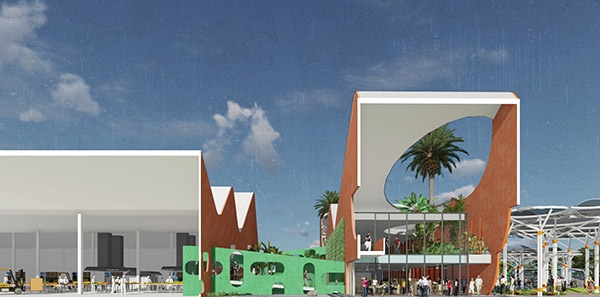
FAYETTEVILLE, Ark. – The University of Arkansas Community Design Center, working with the U of A Resiliency Center, has been awarded a 2018 Green Good Design Award for Green Urban Planning/Landscape Architecture by the European Centre for Architecture Art Design and Urban Studies and the Chicago Athenaeum: Museum for Architecture and Design.
The winning proposal, "Whitmore Community Food Hub Complex: Building Community around Food," would help bring locally produced food to Hawaii, where 93 percent of the food is imported. In addition to providing logistics for an underserved agricultural community, the Whitmore complex would serve additional community needs through micro-housing for the agricultural workforce, retail, business incubation and cultural tourism.
"Our project team's relationship with the state of Hawaii is based on the use of design thinking to address systemic challenges related to food security," said Steve Luoni, director of the Community Design Center. "It is enormously gratifying to be part of a multi-sectoral effort that values the role of placemaking in advancing community resilience and business incubation in local agriculture."
Luoni is also a Distinguished Professor and the Steven L. Anderson Chair in Architecture and Urban Studies. The center is an outreach program of the Fay Jones School.
The project was a collaborative effort between the Community Design Center and the U of A Resiliency Center, an interdisciplinary sustainability initiative hosted by the Fay Jones School.
Marty Matlock is the executive director of the U of A Resiliency Center and a professor in the Department of Biological and Agricultural Engineering in the College of Engineering at the university.
"This project highlights the creative value of the Resiliency Center's interdisciplinary collaboration across food, water and community systems," Matlock said. "The Whitmore Community Food Hub design is a model not only for the neighbor islands in Hawaii, but for Pine Bluff and Springdale, Arkansas. We are reinventing food supply chains from the producer to the consumer, with a clear focus on economic, social and environmental sustainability."
This is the third time these collaborators have received a Green Good Design Award together. The project was sponsored by the Agribusiness Development Corporation of the Hawaii Department of Agriculture.
The proposed Food Hub would serve Oahu communities while advancing a "missing middle" agricultural infrastructure template for community-based food production among Hawaii's neighbor islands.
Four principles guided the planning and design of the 34-acre Whitmore Food Hub Complex: logistics, placemaking, connectivity and anchoring. The complex provides a Food Hub that meets the stringent requirements of the forthcoming Food Safety Modernization Act. It integrates the logistical spaces of the Food Hub with surrounding neighborhoods through serial public spaces that sponsor multiple uses. It connects the Food Hub and Whitmore Village to downtown Wahiawa, and it uses mixed-use spaces and civic frontages to socialize the Food Hub's big boxes and tilt wall concrete construction.
The project will be exhibited this year at venues in Athens, Dublin and Chicago.
The Green Good Design Award aims to bring public appreciation and awareness to global design projects that emphasize sustainability and ecological restoration.
About the University of Arkansas Community Design Center: The University of Arkansas Community Design Center was founded in 1995 as part of the Fay Jones School of Architecture and Design. The center advances creative development in Arkansas through education, research, and design solutions that enhance the physical environment. It has provided design and planning services to more than 50 communities and organizations across Arkansas, helping them to secure nearly $72 million in grant funding to enact suggested improvements. In addition to revitalizing historic downtowns, the center addresses new challenges in affordable housing, urban sprawl, environmental planning, and management of regional growth or decline. The center's professional staff members are nationally recognized for their expertise in urban and public-interest design, and their work has received more than 150 design and planning awards. For more information, visit uacdc.uark.edu.
About the University of Arkansas: The University of Arkansas provides an internationally competitive education for undergraduate and graduate students in more than 200 academic programs.
Topics
Contacts
Michelle Parks, director of communications
Fay Jones School of Architecture and Design
479-575-4704, mparks17@uark.edu